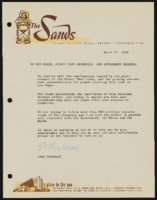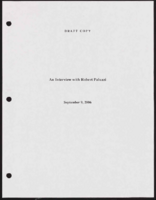Search the Special Collections and Archives Portal
Search Results

Transcript of interview with Ed Collins by Steve Smith, March 15, 1981.
Date
Archival Collection
Description
Text
L. F. Manis Photograph Collection
Identifier
Abstract
The L. F. Manis Photographs contain photographic prints, photographic slides, and photographic negatives depicting Southern Nevada from approximately 1900 to 1969, with a bulk of the materials dating from 1930 to 1940. The photographs primarily depict the construction, dedication, and various parts of the Hoover (Boulder) Dam, including the dam's upstream and downstream faces, intake towers, spillways, bridges, crest, outlet works, visitors' accommodations, and powerhouse. The photographs also depict Lake Mead, the reservoir created by the Hoover Dam, and the Colorado River, which is dammed by the Hoover Dam. The photographs also include views of desert landscapes in the Southwestern United States, including in Nevada, Arizona, and Southern California. Also depicted in the photographs are the cities of Las Vegas, Nevada and Boulder City, Nevada, including prominent buildings like hotels, casinos, government buildings, and train depots.
Archival Collection

1955 atomic test in Nevada: Sands Hotel correspondence, records, and photographs
Date
Archival Collection
Description
Series XVIII. Television, Radio Shows, and Movies
Sands Hotel and Casino
Mixed Content

Transcript of interview with Harvey Diederich by K.J. Evans, January 4, 1999
Date
Archival Collection
Description
Text

Sachiko Young oral history interview: transcript
Date
Archival Collection
Description
Oral history interview with Sachiko Young conducted by Mikaela Nettlow on December 5, 2021 for Reflections: The Las Vegas Asian American and Pacific Islander Oral History Project. Sachiko shares her upbringing in Fukoka, Japan and how she and her family moved frequently as a child. She talks about meeting her husband, an American military man, while visiting family in Tokyo. Sachiko discusses their marriage and birth of their child, their move to San Jose, California, and their travels back and forth from Japan before settling in Las Vegas, Nevada. She shares stories of visiting casinos with friends, working in hotel coffee shops, and what life was like for her and her family. Sachiko also talks of how she and her husband both faced racial prejudice from their families and the difficulties of learning English as a second language.
Text
Louise Meehan Photograph Collection on the Boulder Club
Identifier
Abstract
The Louise Meehan Photograph Collection on the Boulder Club contains three black-and-white photographs of the Boulder Club in Las Vegas, Nevada from 1953. The photographs capture part of the interior of the club and showcase its slot machines, bar, and card room.
Archival Collection

Jack L. Monroe Jr. interview, March 15, 1981: transcript
Date
Archival Collection
Description
On March 15, 1981, Marie Carmichael interviewed Jack L. Monroe Jr. (b. 1937 in St. Helena, California) about his life in Las Vegas, Nevada and his work as a cook among many other topics. Monroe speaks initially about his time working alongside his family in the restaurant business, with his father working as a cook, his mother a waitress and himself as both a busboy and a cook. He discusses the working conditions of cooks, the competition between casino restaurants and the relationship between workers, bosses and the public. Moreover, Monroe speaks about life in Las Vegas as a youngster, the significance of YMCA, summer camps and other recreational activities, and the school system. Lastly, he talks about the changing infrastructure of the city, the paved roads and public transportation, how casinos made their profits and the attachment residents develop towards the city of Las Vegas.
Text

Transcript of interview with Robert Paluzzi by Claytee White, September 5, 2006
Date
Archival Collection
Description
Claytee White interviews Robert Paluzzi on September 5, 2006.
Text


